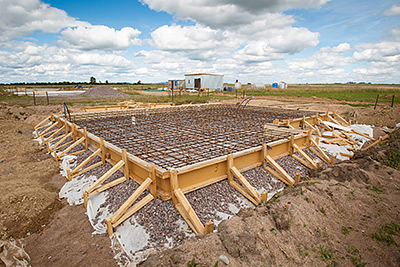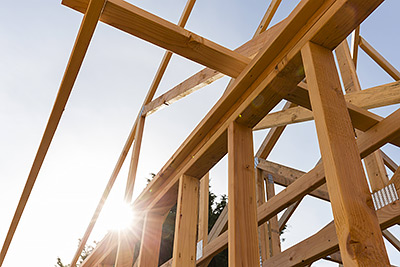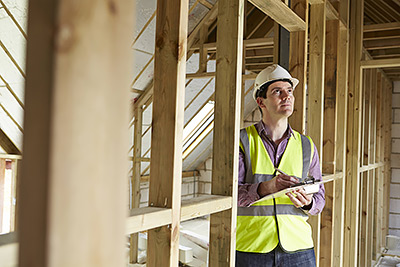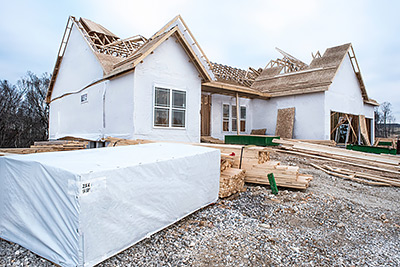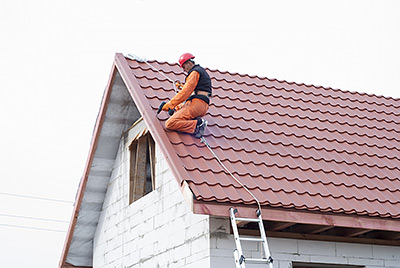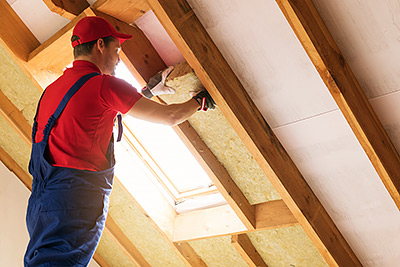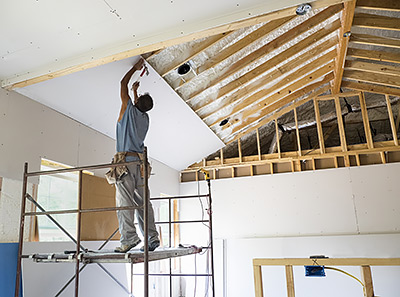Building a New Home: How It Happens
It’s so exciting to build a new home, but we also know it can be overwhelming. At Direct from the Designers, we want you to feel confident in your decision to build rather than buy, so here’s a quick breakdown of the process. Once you familiarize yourself with the basics, building a home won’t seem so daunting!
1. CLEARING THE LOT & POURING THE FOUNDATION: First, your builder needs to prepare the land for the house, which could mean anything from clearing brush and trees to excavating bedrock. Not only does this make room for the house, but it gives you the basis for your foundation. Whatever type it is—basement, slab, crawlspace, piers, etc.—the foundation is essential to the home’s safety and energy efficiency. At the same time, municipal utility connections to the site are put into place, and/or well and septic systems are installed.
Ask for assistance if you don’t know which type of foundation to select. For most, the foundation is poured into forms of framing lumber to give it the shape and strength it needs. The wood can be reused later, but you have to give the concrete time to cure before moving on!
2. FRAMING THE HOUSE: Houses can be framed a number of ways these days. You can choose to build with structural insulated panels (SIPs), steel, or concrete block, but most still use stick framing.
This method raises the skeleton of the house first and then fleshes the walls out. At this point, you can start to see the layout of the home, including rooms, doorways, and windows. Just be aware that the interior seems smaller than it really is at this stage.
3. INSPECTIONS & FRAME WALK: At various points, the house has to be inspected to make sure everything’s done correctly and a safe, up-to-code home results. An inspector will come through with a critical eye, and if there are any issues, your builder will amend them before the build progresses. With all the walls and trusses framed and the roof sheathing installed, the builder will ask you to walk through the house, too, so you can start to envision the final product.
4. INSTALLING HOUSE WRAP: To prevent moisture damage—which can cause mold and wood rot issues—a protective barrier called house wrap is installed around the exterior. This protects the home’s underlying structure and the interior from getting wet. It sets the build up for success in the short and long term!
5. ENCLOSING THE HOME: A house has to pass inspection before it can be enclosed. In this stage, the roofing system, siding, brick and stone accents, and windows, doors, and skylights are installed. All of this contributes to curb appeal, so choose products wisely and consider them an investment toward your property value and resale potential.
Our architects and designers specify products they feel confident in, so if you need somewhere to start, consider their recommendations. They choose authentic stone and brick veneer from Cultured Stone for use inside and out. For entry doors, Therma-Tru® Doors provides quality systems that beautify the entry on the façade and from the foyer. To outfit the garage, check out the dependable garage doors that Clopay® can build with the level of insulation you want. Pella provides gorgeous, high-performance windows that are a great fit for every architectural style and climate zone. Finally, Sun Tunnels, skylights, and roof windows from VELUX® can help brighten and even refresh your interior, too.
6. INSTALLING THE MECHANICALS: Before sheetrock can be hung, mechanical components of the house must be installed in the walls. These include electrical wiring, ductwork and vents, the HVAC system, and the water heater. In many cases, specialized subcontractors come in to do their parts and your builder will oversee the process.
7. INSTALLING INSULATION: Don’t skimp when it comes to insulation, because it determines the energy efficiency of your home and will affect your utility bills. There are different types of insulation, but it is generally inexpensive. Adequate and proper installation in the floors, walls, and ceilings will prevent heat and AC from escaping, and conserve energy and your own money.
8. INSTALLING SHEETROCK: With all the framing, enclosing, and mechanicals in place, sheetrock is used to form the interior side of the walls. The build really starts looking like a house now!
9. INSTALLING INTERIOR FINISHES: For most people, choosing interior finishes is the best part of building their own homes. They get to select everything—like paint, flooring, trim, cabinetry, plumbing and lighting fixtures, and so much more! Think about how you want your dream home to come together.
Our architects prefer appliances from Whirlpool®, KitchenAid®, and JennAir® to suit homes of every budget.
10. FINAL WALK-THROUGH: The final stage of building is the last walk-through. Turn everything on, flip all the switches, test every window and door, open all cabinets, run every faucet, inspect the floor for defects, etc. to ensure there aren’t any issues before you close on the home. If anything needs fixing, notify your builder. The building process isn’t over until everything’s resolved!
BROWSE HOME PRODUCT ARTICLES
- Creating a Spa-Like Master Bathroom »
- Designing a Water-Efficient Bathroom »
- Design a Modern Bathroom »
- View All Bathroom Articles »
- Building a New Home »
- Building a Duplex »
- Finding the Right Home Builder »
- View All Building Tips Articles »
- Adding the Right Columns»
- Decorative Touches for Your Interior»
- Shutters for Every Architectural Style »
- View All Columns & Millwork Articles »
- How to Use Specialty Laminates »
- Decorative Touches for Your Home's Interior
- View All Countertops and Surfaces Articles »
- What Goes Into a Great Deck? »
- Decorative Touches for Your Home's Interior »
- View All Decking Articles »
- Choosing Glass for Your Entry »
- Stylish Personas for Your Front Door »
- Using Sidelites and Transoms »
- View All Door Articles »
- Choose Siding for Your Region »
- Get the Most Out of Exterior Paint »
- Mixing Siding to Define Your Exterior »
- View All Exterior Articles »
- Finding the Right Home Builder »
- The Appeal of Small House Plans »
- Choosing the Perfect Floor Plan »
- View All Finding a Home Plan Articles »
- Colorful Flooring for Your Home »
- Designing With Different Widths»
- Chic, Neutral, Gray Flooring »
- View All Flooring Articles »
- Garage Doors That Add Curb Appeal »
- Caring for Your Garage Doors »
- Benefits of Insulated Garage Doors »
- View All Garage Door Articles »
- Reclaimed Products for Your Home »
- Building a Green and Stylish Home »
- Benefits of Building with SIPS »
- View All Green Building Articles »
- Cool Gadgets for Your New Home »
- Creating a Hi-Tech Home »
- Efficient Gifts for New Homeowners »
- View All Home Electronics Articles »
- Improve Your Home's Air Circulation »
- How to Improve the Air Circulation in Your Home »
- View All HVAC Articles »
- Bedrooms Designed for Sleep »
- Selecting a Fireplace for Your Home »
- Crafting a Luxurious Master Suite »
- View All Interior Design Articles »
- Design the Perfect Outdoor Space »
- Dive into a Beautiful Pool »
- Design a Sizzling Outdoor Kitchen »
- View All Outdoor Living Articles »
- Apps to Help You Pick Paint Colors »
- Create the Perfect Mood with Paint »
- How to Read the Color Wheel »
- View All Painting & Decorating Articles»
- Creating a Spa-Like Master Bathroom »
- High-Impact Kitchen Upgrades »
- Creating a Water Efficient Bathroom »
- View All Plumbing Fixtures Articles»
- Cladding That Complements Your Exterior »
- Reasons to Consider Prefinished Siding »
- View All Siding & Cladding Articles»
- All About Solar Powered Skylights »
- Natural Lighting for the Dark Corners of Your Home »
- Design a Better Bedroom with Skylights »
- View All Skylight Articles»
.png)
.png)
